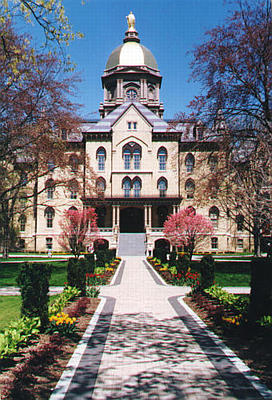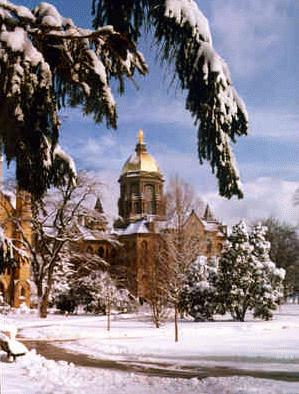
Notre Dame's Grotto / by Dorothy V. Corson


The Rededication of the New Notre Dame
Because of delays, the rededication of the "New Notre Dame," planned for September 8, 1879, the Feast of the Nativity of the Blessed Virgin, was postponed. A solemn High Mass was celebrated on that day instead, at the beginning of the school session, less than five months after the fire. Rev. W. Corby, President of the University, addressed eloquent words of instruction and wisdom to the students.
Education without religion or moral training, is a very dangerous thing. It is like a sharp tool in the hands of an infant. The tools in themselves are good, fit for use by those who know how to handle them, but destructive to those who know not how to use them -- even death dealing, at times, to the infant. So education without moral training is one of the most dangerous instruments used by the enemy of man's salvation for a greater destruction -- death to the souls of men.
Every day we read of crimes, . . . not committed by the uneducated only; no, but by those who had received an education above the common, but devoid of moral training. . . . While these men's intellects were well trained, the heart and the morals were neglected. . . . It is time for the educators of the country to take this matter into consideration. The sooner they do, the sooner we may look for a nation of citizens whose lives will be an example of truth, honor, justice, and all that makes men noble. . . . It must therefore be the aim of all true educators to develop the moral as well as the mental faculties in those committed to their charge.(75)
Stories abound about the new colossal statue of the Blessed Virgin created for the new Dome. It arrived on campus in the summer of 1880. It was placed on the front porch of the newly constructed Main Building -- a Lady in waiting -- until the Dome was prepared to receive her statue. For three years she adorned the porch awaiting ascent to the top of her pedestal on the finished Dome.
Many local families have passed on family remembrances of ancestors who helped hoist the statue to the Dome, as many farmers of the day must have done. Records show they often joined forces in assisting their neighbor, Notre Dame, with tasks that required man and horse power. Similar stories were passed on regarding the building of the present Grotto.
One descendent of an alumnus of those days, Mary Roemer, remembers hearing a family story of how the statue of Our Lady was brought by wagon from the train station pulled by a team of six or eight white horses. "Sounds like a fairy tale, doesn't it," she said. She explained that it was just a long ago remembrance. She had no way of knowing where it came from.
It's a story that could easily have been true. The heavy statue would have been transported from the train station by wagon. Such a momentous ceremonial occasion might have warranted a team of all white horses.
No confirmation of her story has been found, but another amusing anecdote about an uncompromising Father Sorin turned up in an unpublished manuscript in the University Archives. It was written by the first Father J. W. Cavanaugh. He describes Father Sorin's vision of Our Lady atop a Golden Dome and his unrelenting efforts to accomplish it.
When the council repeatedly refused Sorin the Dome and Our Lady, Father Sorin rose and with a fine blend of dignity and indignation gathered up his breviary and his pajamas, or whatever was used for pajamas in those days, and started to St. Mary's. Over there just off the regular parlor was a small room called by the irreverent the "Puppy-hole," in which Father Sorin often retired to recite his office without distraction. Father Sorin took up his post there and remained for two weeks like Achilles skulking in his tent, declaring that never would he return to Notre Dame until he was allowed to carry out his plans for the big dome carved with a beautiful figure of Our Lady.
In desperation the members of the council decided that they had better yield. A committee was sent to St. Mary's with their hats in their hands to beg Fr. Sorin to return, assuring him he could have his dome.
There will be those, of course, who will find something less than perfect in the religious attitude of Fr. Sorin throughout this episode. It is fair enough that they should have their opinion. Others will marvel at what seems to be the uncompromising spirit, the hardheadedness, the obstinacy of a man, whose great role of a founder and builder of a college in a wilderness must have been a reasonable compromise. Whoever looks at the beautiful campus now and considers how different the whole thing would appear without the dome will hesitate to entertain either suggestion. The truth is that the dome upon the Administration Building assembles all the other buildings on the campus around it and contributes to each a dignity which, otherwise, it would not possess.(76)
